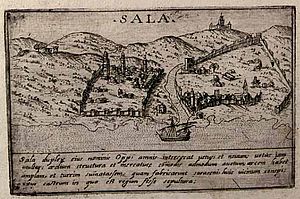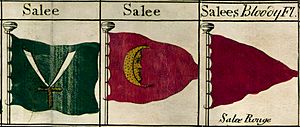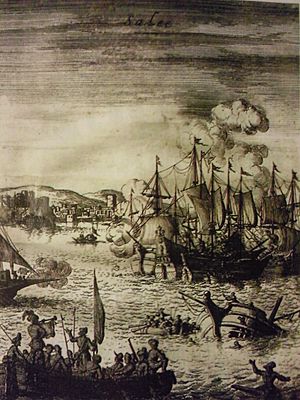Republic of Salé facts for kids
Quick facts for kids
Bou Regreg Republic
|
|||||||||
|---|---|---|---|---|---|---|---|---|---|
| 1627–1668 | |||||||||

Rabat-Salé, where the republic was located.
|
|||||||||
| Status | Under the suzerainty of the Zawiya Dila'iya (1641–1661) | ||||||||
| Capital | Kasbah | ||||||||
| Common languages | Arabic Spanish Spanish-based lingua franca |
||||||||
| Government | Corsair republic | ||||||||
| Commander | |||||||||
|
• 1627–1641
|
Sidi al-Ayachi | ||||||||
| Governor | |||||||||
|
• 1651–1661
|
Abdullah ibn Mohammed al-Hajj | ||||||||
| History | |||||||||
|
• Established
|
1627 | ||||||||
|
• Disestablished
|
1668 | ||||||||
| Area | |||||||||
| 1624–1668 | 0.91 km2 (0.35 sq mi) | ||||||||
| Population | |||||||||
|
• 1627–1640
|
13,000 | ||||||||
|
|||||||||
| Today part of | Morocco | ||||||||
The Republic of Salé, also known as the Bou Regreg Republic and the Republic of the Two Banks, was a city-state maritime corsair republic based at Salé in Morocco during the 17th century, located at the mouth of the Bou Regreg River. It was founded by Moriscos from the town of Hornachos, in Western Spain. The Moriscos were the descendants of Muslims who were nominally converted to Christianity, and were subject to mass deportation during Philip III's reign, following the expulsion of the Moriscos decrees. The republic's main commercial activities were the Barbary slave trade and piracy during its brief existence in the 17th century.
History
Arrival of the Moriscos
The republic traces its origins back to the beginning of the 17th century, with the arrival of approximately 3,000 wealthy Moriscos from Hornachos in Extremadura, who anticipated the 1609 expulsion edicts ordered by Philip III of Spain. After 1609, approximately 10,000 down-and-out expelled Moriscos arrived from Spain. Cultural and language differences between the native Salétin people and the Morisco refugees led the newcomers to settle in the old medina of Rabat, on the opposite bank of the Bou Regreg.
In 1614 Brahim Vargas became the first governor of the Republic of Salé, a famous corsair who managed to make the old medina of Rabat very rich and prosperous by engaging in piracy and trade with Spain and other countries bordering the Mediterranean, for which he to have a very important fleet of galleons that was quite feared even by the most important naval powers of that time. Pirates based on the western bank thrived and expanded their operations throughout the Mediterranean and the Atlantic Ocean. In 1624, the Dutchman Jan Janszoon, also known as Murad Reis, became the "Grand Admiral" of the Corsair Republic of Salé. He hired a fellow countryman from the Netherlands, Mathys van Bostel Oosterlinck, who would serve as his Vice-Admiral. The Saadi Sultan Zidan Abu Maali acknowledged Janszoon's election by formally appointing him as his ceremonial governor.
Independence
In April 1627, with the support of Sidi al-Ayachi, the Hornacheros expelled the Sherif's governor and constituted themselves a virtually independent republic. The English diplomat John Harrison negotiated a treaty with Sidi al-Ayachi in May, a month after their coup d'état. After Janszoon left Salé in 1627, the Moriscos ceased to recognize the authority of the Sultan Zidan Abu Maali, and refused to pay his tithe on their incomes. They proclaimed a republic, in the image of medieval Italian city-states like Venice or Genoa, ruled by a council or Diwan, a sort of government cabinet formed by 12 to 14 notable people whose members annually elected a Governor and a Captain General of the Fortalesa during the month of May. In the early years of the republic, between 1627 and 1630, the Diwan was controlled only by the Hornacheros, whose grip on power was resented by the growing population of non-Hornachero Moriscos, called Andalusians. After bloody clashes in 1630, an agreement was reached: the election of a Qaid by Andalusians and a new Diwan of 16 members of whom 8 were Andalusians and 8 Hornacheros.
Decline
In 1641 the Zawiya Dila'iya, which controlled much of Morocco, imposed a religious hegemony over Salé and its parent republic. By the early 1660s the republic was embroiled in war with the Zawiya, and eventually, in June 1668, Sultan Moulay al-Rashid of the Alaouite dynasty, which still rules Morocco into the 21st century, vanquished the Dilaites and Khadir Ghaïlan's influence and ended the republic's independence.
Piracy
Piracy in Salé began with the arrival of the Moors from Spain, whose wealth allowed them to acquire some ships. With them they traveled the seas, approaching mainly Spanish ships, giving 10% of their loot (both riches and captives) to the Saadians, before they successfully rebelled against the authority of the Emperor of Morocco. In 1625 the Salé Rovers carried off captives from Plymouth in England; in 1626 five ships were seized off the coast of Wales; in 1627 they reached Iceland and sacked the city of Reykjavik and raided the fishing village of Grindavík, in what is known as the Turkish Abductions. Their ships then sailed to Bessastaðir, home of the Danish-Norwegian governor of Iceland, to raid but were unable to make a landing. They also captured the island of Lundy in the Bristol Channel and held it for five years, using it as a base for raiding expeditions. A great deal of activity was centered in the waters between England and Ireland. In the Newfoundland banks the Salétin fleet captured more than 40 fishing vessels in the space of two years, and in 1624 a dozen or so ships from Salé appeared on the coasts off Acadia or Nova Scotia. In 1631 Murad Reis led the Sack of Baltimore in Ireland.
European agents, sent mostly to deal with questions arising from piracy or connected with commerce, dealt directly with the Andalusians, From 1643 there was a Dutch consul in Salé, and in 1648 the French government appointed a substantive consul to reside there, after having been satisfied since 1629 with having a merchant living in Marseille act as consul while having an agent in Salé.
Legacy
Piracy, although in decline as was the commercial activity of the city, remained in Salé long after the republic ceased to exist. The attempt of Sidi Mohammed III (1757–1790) to officially revive piracy only accelerated the decline of the city and its corsair activity. The foundation of Mogador in 1760, as a better equipped city to the needs of modern piracy, was a fatal blow to the port of the Bou Regreg. In 1818 Sultan Moulay Slimane officially renounced the holy war and liquidated the Sherifian Navy, definitively putting an end to Salé as a corsair city.
The descendants of Brahim Vargas are the current Bargach of Rabat, which was, and continues to be, an influential family in the Moroccan capital. The Vargas/Bargach saga has remained linked to the government of Rabat for nearly four hundred years.
See also
 In Spanish: República de Salé para niños
In Spanish: República de Salé para niños
- Thalassocracy
- Barbary Coast
- Barbary pirates
- Slave raid of Suðuroy








